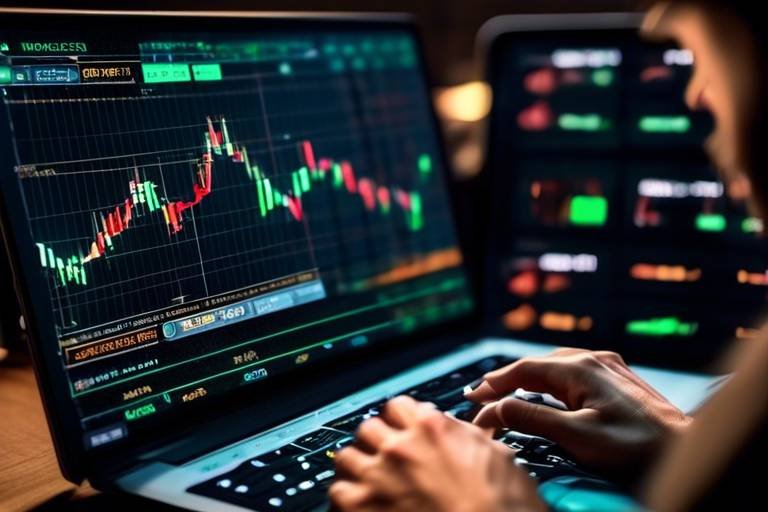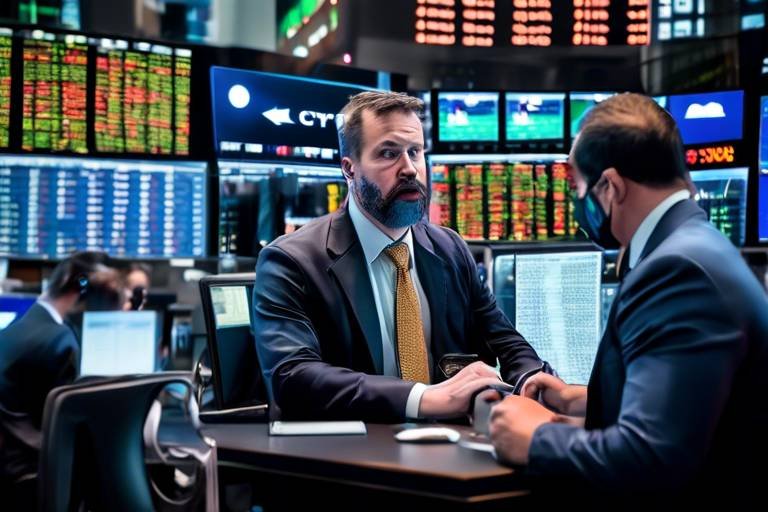The Impact of AI on Cryptocurrency Trading
In recent years, the world of cryptocurrency trading has witnessed a seismic shift, largely driven by the advent of artificial intelligence (AI). As traders grapple with the complexities of digital currencies, AI emerges as a beacon of hope, enhancing decision-making processes and enabling more informed strategies. But how exactly is AI transforming this tumultuous landscape? Well, let’s dive in and explore the profound impact AI has on cryptocurrency trading.
Imagine trying to navigate a bustling city without a map or GPS. That’s what trading cryptocurrencies can feel like, especially with the market’s notorious volatility. Enter AI, which acts like a sophisticated navigation system, helping traders make sense of the chaos. By analyzing vast amounts of data at lightning speed, AI tools can identify trends, predict market movements, and even execute trades on behalf of the user. This not only saves time but also significantly boosts the chances of making profitable trades.
The implications of AI in cryptocurrency trading extend beyond mere data analysis. With machine learning algorithms continuously evolving, these systems learn from past trades and market behaviors, improving their accuracy over time. It’s akin to having a seasoned trader by your side, one who learns from every mistake and triumph, refining their strategies to maximize returns. As we explore the various aspects of AI's influence on trading, it becomes clear that this technology is not just a passing trend; it's reshaping the very foundation of how trading is conducted in the digital currency realm.
As we delve deeper into the specifics, we’ll uncover how AI-powered trading algorithms, sentiment analysis, and advanced risk management techniques are revolutionizing the game. So buckle up, because the journey through the intersection of AI and cryptocurrency trading is just getting started!
Artificial intelligence has increasingly become integral in financial markets, revolutionizing trading strategies and risk management. This section examines AI's emergence and its implications for cryptocurrency trading.
AI-driven trading algorithms analyze vast amounts of data to identify trends and make predictions. This section discusses how these algorithms operate and their effectiveness in cryptocurrency trading environments.
Machine learning techniques enable algorithms to adapt and improve over time. This subsection delves into specific machine learning methods used in cryptocurrency trading, highlighting their advantages and limitations.
Supervised learning involves training models on labeled datasets to predict future outcomes. This part focuses on how supervised learning is applied to enhance trading strategies in the crypto market.
Reinforcement learning allows algorithms to learn from their actions and experiences. This segment explores how this approach is utilized in cryptocurrency trading for optimizing decision-making processes.
Sentiment analysis leverages AI to gauge market sentiment from social media and news sources. This subsection examines its role in predicting market movements and informing trading strategies.
AI enhances risk management by providing real-time insights and predictive analytics. This section highlights how AI tools help traders manage risks more effectively in the volatile cryptocurrency market.
Automated risk assessment tools analyze market conditions and trader behavior. This part discusses how these tools assist in identifying potential risks and mitigating losses in cryptocurrency trading.
AI-driven portfolio optimization strategies help traders maximize returns while minimizing risks. This subsection outlines the techniques used for effective portfolio management in the crypto space.
- What is AI in cryptocurrency trading?
AI refers to the use of algorithms and machine learning techniques to analyze market data, predict trends, and automate trading decisions in the cryptocurrency market. - How does AI improve trading strategies?
AI enhances trading strategies by providing insights from large datasets, identifying patterns, and allowing for real-time decision-making that can adapt to market changes. - Are AI trading algorithms reliable?
While AI trading algorithms can significantly improve trading accuracy, they are not foolproof. Market volatility and unforeseen events can still lead to losses. - Can anyone use AI for cryptocurrency trading?
Yes, many platforms offer AI-driven trading tools that are accessible to both novice and experienced traders, making it easier for anyone to leverage this technology.

The Rise of AI in Financial Markets
Artificial intelligence (AI) has become a game-changer in the realm of financial markets, and its influence is particularly evident in the world of cryptocurrency trading. Imagine a bustling marketplace where decisions are made in an instant, driven by vast amounts of data that humans simply can’t process quickly enough. This is where AI steps in, acting like a high-speed train cutting through the fog of uncertainty, illuminating the path for traders. As cryptocurrencies continue to gain traction, the integration of AI into trading strategies is not just a trend but a necessity for staying competitive.
In recent years, we’ve witnessed a remarkable surge in the adoption of AI technologies across various sectors, and finance is no exception. From algorithmic trading to risk assessment, AI’s capabilities are reshaping how traders interact with the market. This transformation is not merely about automation; it’s about enhancing decision-making and improving market analysis. Traders are now equipped with tools that analyze market data at lightning speed, identifying patterns and trends that might go unnoticed by the human eye.
One of the most significant implications of AI in cryptocurrency trading is its ability to process unstructured data. Traditional trading methods often rely on historical data and technical indicators, but AI can also analyze social media feeds, news articles, and even sentiment from forums. This multifaceted approach allows traders to gauge market sentiment more accurately, making informed decisions based on a broader spectrum of information. For instance, a sudden spike in social media chatter about a particular cryptocurrency can signal a potential price surge, and AI can flag this in real-time, giving traders a competitive edge.
Furthermore, the rise of AI in financial markets has led to the development of sophisticated trading algorithms that can execute trades automatically based on predefined criteria. These algorithms can operate 24/7, tirelessly scanning the market for opportunities while human traders catch some much-needed sleep. In a world where cryptocurrency prices can fluctuate wildly within minutes, having AI algorithms at your disposal can be the difference between profit and loss.
However, it’s essential to recognize that while AI offers incredible advantages, it is not without its challenges. The cryptocurrency market is notoriously volatile, and relying solely on AI can lead to unforeseen risks. Traders must strike a balance between automated trading and human intuition, ensuring that they remain vigilant and informed about market conditions. As we continue to explore the impact of AI on cryptocurrency trading, it’s crucial to understand both the benefits and potential pitfalls of this technological revolution.
In conclusion, the rise of AI in financial markets, particularly in cryptocurrency trading, signifies a paradigm shift that is here to stay. With its ability to enhance decision-making, improve market analysis, and automate trading strategies, AI is transforming how traders operate in an increasingly complex digital currency landscape. As we look to the future, one thing is clear: embracing AI technology will be key for traders aiming to thrive in this dynamic environment.

AI-Powered Trading Algorithms
In the fast-paced world of cryptocurrency trading, are becoming the backbone of many successful trading strategies. These advanced algorithms leverage the power of artificial intelligence to sift through mountains of data, identifying patterns and trends that would be nearly impossible for a human trader to discern. Imagine trying to find a needle in a haystack; now, picture having a magnet that not only finds the needle but also predicts where more needles might appear. That's the power of AI in trading!
At the core of these algorithms is a complex interplay of data analysis, machine learning, and predictive modeling. They analyze historical price movements, trading volumes, and even external factors like news headlines and social media sentiment. By doing so, they can make informed predictions about future price movements, allowing traders to make decisions based on data rather than gut feelings. This shift from instinct to analytics is nothing short of revolutionary in a market known for its volatility.
One of the most fascinating aspects of AI trading algorithms is their ability to operate in real-time. Unlike traditional trading methods that require manual input and analysis, AI algorithms can execute trades in the blink of an eye. They continuously monitor market conditions and can react to changes in seconds, which is crucial when every millisecond counts. This capability not only improves trading efficiency but also significantly enhances the potential for profit.
To give you a clearer picture, let's break down some of the key functionalities of AI-powered trading algorithms:
- Data Collection: They gather data from various sources, including market exchanges, financial news, and social media.
- Trend Analysis: They identify trends and correlations in the data, helping traders understand market dynamics.
- Decision Making: They make predictions about future price movements based on the analyzed data.
- Automated Trading: They can execute trades automatically based on predefined criteria, removing emotional bias from trading decisions.
However, it's not all sunshine and rainbows. While AI trading algorithms are powerful, they are not infallible. The market can be unpredictable, and algorithms are only as good as the data they are trained on. If the data is flawed or if there are sudden market shifts that the algorithm hasn't accounted for, it can lead to significant losses. This is why continuous monitoring and adjustment of these algorithms are essential.
Furthermore, the effectiveness of these algorithms can vary based on the strategies they employ. Some may focus on high-frequency trading, executing thousands of trades per second, while others might adopt a more strategic approach, holding assets for longer periods based on broader market trends. Understanding the different types of AI algorithms and their applications is crucial for traders looking to harness their full potential.
In summary, AI-powered trading algorithms are transforming the landscape of cryptocurrency trading. They offer traders the ability to make data-driven decisions, react to market changes in real-time, and optimize their trading strategies. However, as with any tool, the key to success lies in understanding how to use it effectively. With the right approach, these algorithms can be a game-changer in your trading journey.

Machine Learning Techniques
When we talk about the intersection of machine learning and cryptocurrency trading, it's like opening a treasure chest filled with innovative tools and techniques that can significantly enhance trading strategies. Imagine having a virtual assistant that not only learns from past experiences but also evolves with every new piece of data it encounters. That's the essence of machine learning in the crypto world. These techniques allow algorithms to analyze vast datasets, identify patterns, and make informed predictions about market movements.
One of the most exciting aspects of machine learning is its adaptability. Unlike traditional trading methods that rely heavily on static rules, machine learning algorithms can adjust their strategies based on new information. For instance, if a particular trading strategy starts to underperform, the algorithm can recognize this shift and modify its approach accordingly. This dynamic nature is crucial in the fast-paced world of cryptocurrency, where market conditions can change in the blink of an eye.
There are several machine learning techniques that traders can leverage, each with its unique strengths:
- Supervised Learning: This technique involves training algorithms on labeled datasets, allowing them to learn from historical data and make predictions about future price movements. Think of it as teaching a child to recognize animals by showing them pictures and telling them the names.
- Unsupervised Learning: Unlike supervised learning, this method doesn't rely on labeled data. Instead, it identifies hidden patterns within the data. It's like finding a needle in a haystack—sometimes you stumble upon valuable insights without even looking for them.
- Reinforcement Learning: This technique is akin to training a pet. The algorithm learns through trial and error, receiving rewards for good decisions and penalties for poor ones. In the context of trading, it continuously refines its strategies based on the outcomes of its trades.
Each of these techniques offers unique advantages and limitations. For example, supervised learning can yield high accuracy but requires a significant amount of labeled data, which may not always be available in the crypto market. On the other hand, unsupervised learning can uncover hidden patterns but may lack the precision needed for specific predictions.
In summary, machine learning techniques are transforming cryptocurrency trading by providing traders with the tools to analyze data more effectively and make smarter decisions. As these technologies continue to evolve, we can expect even more sophisticated approaches to emerge, further enhancing our ability to navigate the complexities of the crypto market.
Q: What is machine learning in cryptocurrency trading?
A: Machine learning in cryptocurrency trading refers to the use of algorithms that can analyze data, identify patterns, and make predictions about market movements based on historical data.
Q: How does supervised learning work?
A: Supervised learning involves training a model on labeled data, allowing it to learn from past examples and predict future outcomes based on that learning.
Q: What are the benefits of using reinforcement learning in trading?
A: Reinforcement learning allows algorithms to learn from their actions and adapt their strategies over time, optimizing decision-making processes in trading.
Q: Can machine learning guarantee profits in cryptocurrency trading?
A: While machine learning can enhance trading strategies and decision-making, it does not guarantee profits due to the inherent volatility and unpredictability of the cryptocurrency market.

Supervised Learning in Trading
Supervised learning is a powerful machine learning technique that plays a pivotal role in enhancing trading strategies within the cryptocurrency market. At its core, supervised learning involves training algorithms on labeled datasets, allowing them to make predictions about future outcomes based on historical data. Imagine teaching a child to recognize different animals by showing them pictures and naming each one; similarly, supervised learning algorithms learn from past examples to identify patterns in cryptocurrency price movements and trading volumes.
In the context of cryptocurrency trading, supervised learning can be applied in various ways. For instance, traders can use historical price data, trading volumes, and market indicators to train models that predict future price movements. By feeding the algorithm a comprehensive dataset that includes both successful trades and losses, it learns to distinguish between profitable and unprofitable trades. This predictive capability is crucial in a market characterized by volatility and rapid changes.
One of the significant advantages of supervised learning is its ability to provide insights into how different factors influence market behavior. Traders can utilize techniques such as regression analysis to quantify the relationship between various market indicators and cryptocurrency prices. For example, a model might reveal that an increase in social media mentions correlates with a price surge. This understanding empowers traders to make informed decisions based on data-driven insights rather than relying solely on intuition.
However, it's essential to recognize that supervised learning is not without its limitations. The effectiveness of these models heavily depends on the quality and quantity of the data used for training. If the dataset is biased or lacks sufficient historical examples, the model's predictions may be inaccurate. Additionally, the cryptocurrency market is influenced by numerous unpredictable factors, such as regulatory changes and macroeconomic events, which can challenge the reliability of models based purely on historical data.
To illustrate the impact of supervised learning in trading, consider the following table that outlines some common supervised learning models used in cryptocurrency trading along with their applications:
| Model | Application |
|---|---|
| Linear Regression | Predicting price trends based on historical price data |
| Decision Trees | Identifying key factors influencing price movements |
| Support Vector Machines | Classifying market conditions to signal buy/sell opportunities |
| Neural Networks | Complex pattern recognition and prediction of price volatility |
In conclusion, supervised learning stands out as a vital tool for traders looking to navigate the complexities of the cryptocurrency market. By leveraging historical data to inform their strategies, traders can enhance their decision-making processes and ultimately improve their chances of success. Nevertheless, it's crucial to approach these models with a critical eye, recognizing their limitations and the ever-changing nature of the crypto landscape.

Reinforcement Learning Applications
Reinforcement learning (RL) is a fascinating subset of machine learning that mimics the way humans and animals learn from their environments. In the context of cryptocurrency trading, RL is particularly powerful because it allows algorithms to learn from their own actions and the outcomes of those actions. Imagine a trader who learns from each trade they make, adjusting their strategies based on what works and what doesn’t. This is precisely what reinforcement learning does, enabling traders to adapt dynamically to the ever-changing market conditions.
At its core, reinforcement learning operates on the principle of trial and error. An RL algorithm interacts with the trading environment by making decisions, receiving feedback in the form of rewards or penalties, and then adjusting its strategies accordingly. For instance, if the algorithm makes a profitable trade, it receives a reward, reinforcing that behavior. Conversely, if a trade results in a loss, the algorithm learns to avoid that strategy in the future. This continuous learning process makes RL particularly suited for the volatile nature of cryptocurrency markets.
One of the most compelling applications of reinforcement learning in crypto trading is in the development of automated trading systems. These systems can analyze vast amounts of market data and execute trades at lightning speed based on learned strategies. By employing RL, these trading bots can identify optimal entry and exit points, manage risks, and even adjust their strategies in real-time based on market fluctuations. The combination of speed and adaptability is what gives RL-powered trading systems a significant edge over traditional methods.
To illustrate how reinforcement learning can be applied in cryptocurrency trading, consider the following table that outlines the key components involved:
| Component | Description |
|---|---|
| Agent | The trading algorithm that makes decisions based on market data. |
| Environment | The cryptocurrency market where trades are executed. |
| Actions | Possible decisions the agent can make, such as buy, sell, or hold. |
| Rewards | Feedback received from the environment based on the actions taken. |
Moreover, reinforcement learning can be particularly effective in portfolio management. By evaluating the performance of various assets over time, RL algorithms can learn to allocate resources more effectively, balancing risk and reward. This is crucial in the cryptocurrency space, where the volatility of assets can lead to significant gains or losses in a short period. By continuously learning from past performance and adjusting the portfolio accordingly, traders can achieve better risk-adjusted returns.
In summary, reinforcement learning applications in cryptocurrency trading are revolutionizing how traders approach the market. By leveraging the principles of trial and error, RL algorithms can adapt to market conditions, optimize trading strategies, and enhance overall performance. As the technology continues to evolve, we can expect to see even more innovative applications of reinforcement learning in the crypto trading arena, ultimately making trading smarter and more efficient.
- What is reinforcement learning? Reinforcement learning is a type of machine learning where an algorithm learns to make decisions by receiving rewards or penalties based on its actions.
- How does reinforcement learning apply to cryptocurrency trading? RL algorithms can analyze market conditions and learn from their trading actions to optimize strategies and improve decision-making.
- What are the benefits of using RL in trading? The main benefits include enhanced adaptability to market changes, improved risk management, and the ability to execute trades at high speeds.
- Can RL be used for portfolio management? Yes, RL can help manage portfolios by learning from past performance and optimizing asset allocation to maximize returns while minimizing risks.

Sentiment Analysis in Crypto Trading
In the fast-paced world of cryptocurrency trading, understanding the mood of the market can be as crucial as analyzing charts and price trends. This is where sentiment analysis comes into play. By leveraging artificial intelligence, traders can gauge the overall sentiment surrounding a particular cryptocurrency, which can significantly influence market movements. Imagine being able to read the collective emotions of thousands of traders and investors—this is the power of sentiment analysis!
Sentiment analysis employs various techniques to sift through massive amounts of data generated from social media platforms, news articles, and forums. By using natural language processing (NLP), AI algorithms can determine whether the sentiment is positive, negative, or neutral. This allows traders to make informed decisions based not just on numerical data, but on the underlying feelings driving the market. For example, if a popular cryptocurrency is trending negatively on social media, it might signal a potential drop in its price, prompting traders to act swiftly.
One of the key benefits of sentiment analysis in crypto trading is its ability to provide real-time insights. Unlike traditional methods that rely on historical data, sentiment analysis captures the current mood of the market, allowing traders to react promptly. This immediacy can be a game-changer, especially in a market known for its volatility. By keeping an ear to the ground, traders can anticipate price movements before they happen.
To illustrate the impact of sentiment analysis, consider the following table that summarizes its effectiveness:
| Aspect | Impact |
|---|---|
| Market Prediction | Improved accuracy by analyzing public sentiment |
| Risk Management | Identifies potential downturns based on negative sentiment |
| Decision Making | Informs traders on when to buy or sell |
However, sentiment analysis is not without its challenges. The interpretation of sentiment can be subjective, and the algorithms must be trained to distinguish between genuine sentiment and noise. Furthermore, the crypto market is influenced by a myriad of factors, and sentiment alone may not provide a complete picture. Therefore, successful traders often combine sentiment analysis with other analytical tools to create a more holistic trading strategy.
In conclusion, sentiment analysis represents a powerful tool for cryptocurrency traders looking to gain an edge in the market. By understanding the emotional landscape of traders and investors, one can make more informed decisions that align with market trends. As AI technology continues to evolve, the accuracy and applicability of sentiment analysis in crypto trading will likely become even more sophisticated, paving the way for a new era of trading strategies.
- What is sentiment analysis? Sentiment analysis is a method used to gauge the emotional tone behind a series of words, often used to understand public opinion in financial markets.
- How does sentiment analysis benefit cryptocurrency trading? It helps traders predict market movements based on the collective sentiment of investors, allowing for more informed trading decisions.
- What tools can be used for sentiment analysis? Various AI-powered tools are available, including social media monitoring platforms and news sentiment analysis software.
- Is sentiment analysis foolproof? No, while it provides valuable insights, it should be used alongside other analysis methods for the best results.

Risk Management with AI
In the fast-paced world of cryptocurrency trading, managing risk is not just a necessity; it's a survival skill. With the market's notorious volatility, traders constantly seek innovative ways to shield their investments from unforeseen downturns. This is where artificial intelligence (AI) steps in, providing a robust framework for risk management that is both proactive and reactive. AI tools are designed to analyze vast amounts of data in real-time, allowing traders to make informed decisions that can significantly reduce their exposure to risk.
One of the primary advantages of AI in risk management is its ability to deliver real-time insights. Imagine having a personal assistant who never sleeps, tirelessly analyzing market trends, news, and social media chatter to identify potential threats. This is precisely what AI does—it continuously monitors the market landscape, providing traders with timely alerts about significant changes that could impact their positions. For instance, if a sudden drop in Bitcoin's value is detected, AI systems can immediately notify traders, enabling them to take swift action.
Moreover, AI enhances risk management through predictive analytics. By utilizing historical data and advanced statistical models, AI algorithms can forecast potential market movements with remarkable accuracy. This predictive capability allows traders to prepare for various scenarios, whether they involve bullish surges or bearish declines. With AI, traders can simulate different market conditions and assess how their portfolios might perform, thus enabling them to make strategic adjustments ahead of time.
Automated risk assessment tools are another game-changer in the realm of cryptocurrency trading. These tools leverage AI to evaluate both market conditions and individual trader behavior. For example, they can analyze a trader's historical performance and current market trends to identify potential risks. This analysis can lead to recommendations on position sizing, diversification, and even the timing of trades. By automating this process, traders can save time and reduce emotional biases that often cloud judgment in high-pressure situations.
To illustrate the importance of automated risk assessment, consider the following table that summarizes the key features and benefits:
| Feature | Benefit |
|---|---|
| Real-time Market Analysis | Immediate identification of risks and opportunities |
| Behavioral Analysis | Personalized risk management strategies based on trading history |
| Scenario Simulation | Preparation for various market conditions |
Another facet of AI's role in risk management is its contribution to portfolio optimization. In a market as unpredictable as cryptocurrency, finding the right balance between risk and reward is crucial. AI-driven portfolio optimization strategies help traders maximize their returns while minimizing risks through sophisticated algorithms that analyze asset correlations, volatility, and market trends.
These strategies can be particularly beneficial in cryptocurrency trading, where assets can display extreme volatility. By employing AI, traders can create diversified portfolios that are less susceptible to market fluctuations. For instance, if a trader holds a mix of established coins like Bitcoin and Ethereum alongside emerging altcoins, AI can analyze the performance of these assets and suggest adjustments to maintain an optimal risk-reward ratio.
In conclusion, the integration of AI into risk management practices in cryptocurrency trading is not just a trend; it's a fundamental shift that empowers traders to navigate the complexities of the market with greater confidence. By leveraging real-time insights, predictive analytics, automated risk assessments, and portfolio optimization strategies, traders can enhance their decision-making processes and ultimately safeguard their investments in this exhilarating yet unpredictable landscape.
- How does AI improve risk management in cryptocurrency trading?
AI enhances risk management by providing real-time insights, predictive analytics, and automated risk assessments, allowing traders to make informed decisions. - What are automated risk assessment tools?
These are AI-driven tools that evaluate market conditions and trader behavior to identify potential risks and recommend strategies to mitigate them. - Can AI help in portfolio optimization?
Yes, AI can analyze asset correlations and market trends to help traders create diversified portfolios that maximize returns while minimizing risks.

Automated Risk Assessment
In the fast-paced world of cryptocurrency trading, tools have become a game-changer for traders seeking to navigate the turbulent waters of digital currencies. These tools leverage the power of artificial intelligence to analyze market conditions and trader behavior in real-time, providing crucial insights that help in identifying potential risks before they escalate. Imagine having a personal assistant who not only alerts you to potential dangers but also offers solutions to mitigate them—this is precisely what automated risk assessment does for traders.
At the heart of automated risk assessment is the ability to process vast amounts of data quickly. Traditional risk assessment methods often rely on manual analysis, which can be time-consuming and prone to human error. In contrast, AI-driven tools can sift through historical data, market trends, and even social media sentiment in mere seconds. This allows traders to stay ahead of the curve, making informed decisions based on up-to-date information.
Moreover, these automated systems utilize sophisticated algorithms to evaluate various factors that contribute to risk. For instance, they assess market volatility, liquidity, and even the behavior of other traders. By doing so, they can provide a comprehensive risk profile that helps traders understand their exposure and make adjustments accordingly. The following table illustrates some key components that automated risk assessment tools analyze:
| Risk Factor | Description | Impact on Trading |
|---|---|---|
| Market Volatility | Fluctuations in asset prices over a specific period. | High volatility can lead to significant gains or losses. |
| Liquidity | How easily an asset can be bought or sold without affecting its price. | Low liquidity can increase the risk of slippage. |
| Trader Behavior | Patterns and actions of other traders in the market. | Can indicate potential market movements or trends. |
One of the most exciting aspects of automated risk assessment is its ability to learn and adapt. As the algorithms analyze more data, they become better at identifying risks and suggesting optimal strategies for risk management. This adaptability is akin to how a seasoned sailor learns to read the winds and tides over time, making them more adept at navigating storms.
Furthermore, these tools often come with customizable settings that allow traders to define their risk tolerance levels. Whether you are a conservative trader who prefers to play it safe or an aggressive trader looking for high-risk opportunities, automated risk assessment tools can be tailored to fit your unique trading style. This personalization ensures that you are not only aware of risks but also equipped with strategies to manage them effectively.
In summary, automated risk assessment tools are revolutionizing the way traders approach risk in the cryptocurrency market. By providing real-time insights and predictive analytics, these tools empower traders to make informed decisions, ultimately enhancing their chances of success. As the cryptocurrency landscape continues to evolve, embracing such technologies will be crucial for anyone looking to thrive in this dynamic environment.
- What is automated risk assessment? Automated risk assessment uses AI to analyze market data and trader behavior in real-time to identify potential risks.
- How does it benefit cryptocurrency traders? It provides timely insights that help traders make informed decisions, reducing the likelihood of significant losses.
- Can these tools adapt to my trading style? Yes, many automated risk assessment tools can be customized to align with your specific risk tolerance and trading strategies.
- Are automated risk assessment tools reliable? While they significantly enhance risk management, they are not foolproof and should be used in conjunction with other strategies.

Portfolio Optimization Strategies
In the fast-paced world of cryptocurrency trading, having a solid portfolio optimization strategy is crucial for any trader looking to maximize their returns while minimizing risks. With the help of artificial intelligence, traders can now employ sophisticated techniques that were once only available to institutional investors. These strategies not only enhance decision-making but also provide a clear roadmap for navigating the volatile waters of digital assets.
One of the primary methods employed in portfolio optimization is the use of mean-variance optimization. This approach involves analyzing the expected returns of various assets while considering their risk levels. By leveraging AI algorithms, traders can quickly assess a multitude of cryptocurrencies, determining which combinations offer the best balance of risk and reward. Imagine trying to find the perfect recipe for a dish; you want just the right amount of spice (risk) to complement the main ingredients (returns). AI does this by crunching numbers faster than any human could, allowing for real-time adjustments based on market conditions.
Another key strategy is dynamic asset allocation. Unlike traditional methods that may rely on static allocations, AI-powered systems can adapt to changing market dynamics. This means that as certain cryptocurrencies gain traction, the algorithm can reallocate funds automatically to capitalize on these trends. Think of it like a skilled surfer riding the waves; they must constantly adjust their position to stay on top of the swell. Similarly, dynamic asset allocation helps traders stay ahead of market movements.
Furthermore, AI can assist in risk-adjusted return analysis. By evaluating the performance of each asset relative to its risk, traders can identify which investments are truly worth pursuing. This analysis often results in the application of the Sharpe Ratio, a metric that measures the return of an investment compared to its risk. Using AI to automate this process allows traders to focus on strategy rather than getting bogged down in calculations.
Additionally, portfolio optimization can be enhanced through diversification strategies. AI algorithms can suggest a mix of assets that minimizes risk while maximizing potential returns. For example, a well-diversified portfolio might include a combination of established cryptocurrencies like Bitcoin and Ethereum, alongside promising altcoins. By spreading investments across various assets, traders can reduce the impact of any single asset's poor performance. AI helps identify these optimal combinations, ensuring that traders are not putting all their eggs in one basket.
To illustrate the effectiveness of these strategies, consider the following table that compares traditional portfolio management techniques with AI-driven approaches:
| Aspect | Traditional Portfolio Management | AI-Driven Portfolio Management |
|---|---|---|
| Speed of Analysis | Slow, manual calculations | Real-time data processing |
| Adaptability | Static allocations | Dynamic adjustments based on market changes |
| Risk Assessment | Basic historical data | Predictive analytics and real-time insights |
| Diversification | Manual selection | Automated optimization of asset mix |
In conclusion, the integration of AI into portfolio optimization strategies is revolutionizing the way traders approach cryptocurrency investments. By utilizing advanced algorithms and data analysis, traders can make informed decisions that enhance their chances of success. The future of trading is undoubtedly intertwined with AI, and those who embrace these technologies will likely find themselves at a significant advantage in the ever-evolving landscape of digital currencies.
- What is portfolio optimization? Portfolio optimization is the process of selecting the best mix of assets to achieve a desired return while minimizing risk.
- How does AI improve portfolio optimization? AI enhances portfolio optimization by providing real-time data analysis, dynamic asset allocation, and advanced risk assessment techniques.
- Can AI predict cryptocurrency prices? While AI can analyze trends and provide insights, predicting prices with absolute certainty is still challenging due to the volatile nature of cryptocurrencies.
- Is it necessary to use AI for portfolio management? While not necessary, using AI can significantly improve decision-making speed and accuracy in portfolio management.
Frequently Asked Questions
- How is AI transforming cryptocurrency trading?
AI is revolutionizing cryptocurrency trading by enhancing decision-making processes, improving market analysis, and influencing trading strategies. It enables traders to analyze vast amounts of data quickly, making it easier to identify trends and predict market movements.
- What are AI-powered trading algorithms?
AI-powered trading algorithms are sophisticated programs that analyze market data to identify patterns and make informed trading decisions. These algorithms can process massive datasets in real-time, allowing traders to capitalize on opportunities that human traders might miss.
- What role does machine learning play in cryptocurrency trading?
Machine learning plays a crucial role in cryptocurrency trading by allowing algorithms to learn from historical data and adapt over time. This means that as market conditions change, these algorithms can improve their predictive capabilities, leading to better trading outcomes.
- How does sentiment analysis impact trading strategies?
Sentiment analysis leverages AI to assess market sentiment by analyzing social media, news articles, and other sources. By gauging public sentiment, traders can make more informed decisions about when to buy or sell, potentially increasing their profitability.
- What are the benefits of automated risk assessment in trading?
Automated risk assessment tools help traders identify potential risks in real-time by analyzing market conditions and trader behavior. This proactive approach allows traders to mitigate losses and make more informed decisions, ultimately leading to better risk management.
- Can AI help optimize my trading portfolio?
Absolutely! AI-driven portfolio optimization strategies can analyze your investments and market trends to maximize returns while minimizing risks. By utilizing advanced algorithms, traders can make more strategic decisions regarding their asset allocations.



















